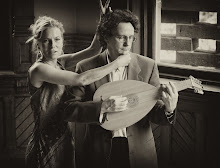
Sonata Variata
To a turn-of-the-seventeenth-century observer, the choice of the violin for Biber’s bold affirmation of the Catholic faith which opens this programme would have been surprising; though sometimes appearing in the visual artwork of churches, the violin’s function was mostly secular at this time. Its role as the ideal instrument to accompany dancing, however, proved to be the key to its longterm success, for the influential and powerful classes placed a high value on that activity.
Thus, violins of transcendant quality first came into existence, such as those the Amati family made around 1550 for the danceband of Charles IX of France, of which only a few survived the French Revolution. Ongoing improvement in the art of violin making in the latter half of the sixteenth century contributed to the development of a kind of super-soprano instrument that could rival the highly-prized cornetto and even the human voice, and was ideally suited to the new trends in musicmaking taking place in Northern Italy, like opera and the sonata.

The first published sonata naming the violin as its treble instrument is the Cima work, dating from 1610. The practice of instrumentalists taking vocal lines and improvising embellishments on them, however, had been around for decades, and we have many written examples to emulate, some of them quite extravagant. Thus, Susanna’s tale of purity and faith can easily get lost in a torrent of virtuoso display. How delightfully seventeenth-century! Although not based on a vocal original, a similar confluence of tuneful melody and elaborate ornament is heard in the sonata by Fontana, from the only extant volume of his works, published posthumously. The scoring of the Frescobaldi piece, with its obligato keyboard part, is highly unusual for this period, but understandable coming from the leading keyboardist of the time.

The name Biagio Marini can be found on the payroll of San Marco in Venice, ostensibly as a singer, but somebody had to play those violin parts that kept cropping up in Monteverdi’s Vespers and other sacred works, so why not have the best? Marini was certainly the most innovative of his generation in the technique of the violin, exploiting its full range and capacity for doublestops, as can be heard in the Sonata Variata. He also travelled widely during his career, bringing Italian innovations to other parts of Europe. Other composers on our programme made long journeys as well.

Baltzar was a native of Lübeck and served at the Swedish court before settling in England, where he did not fail to astonish, especiallly in his ability to play the violin in multiple voices. The Neapolitan Matteis also emigrated to England, and was particularly noted for the quality of his sound production. (“He did wonders upon a Note”).
Muffat is celebrated for his trips to Lully’s France and Corelli’s Rome, but wrote his only violin sonata in Prague, before taking the post of organist at Salzburg Cathedral, where no doubt he knew Biber, the foremost violinist of his generation. Valentini cut his teeth as a violinist and composer in Rome during Corelli’s heyday; the two dances that form the “double-finale” of this sonata have been compared to coffee and dessert. What better way to finish any meal or concert?
Notes by
Sara at the keyboard:



No comments:
Post a Comment